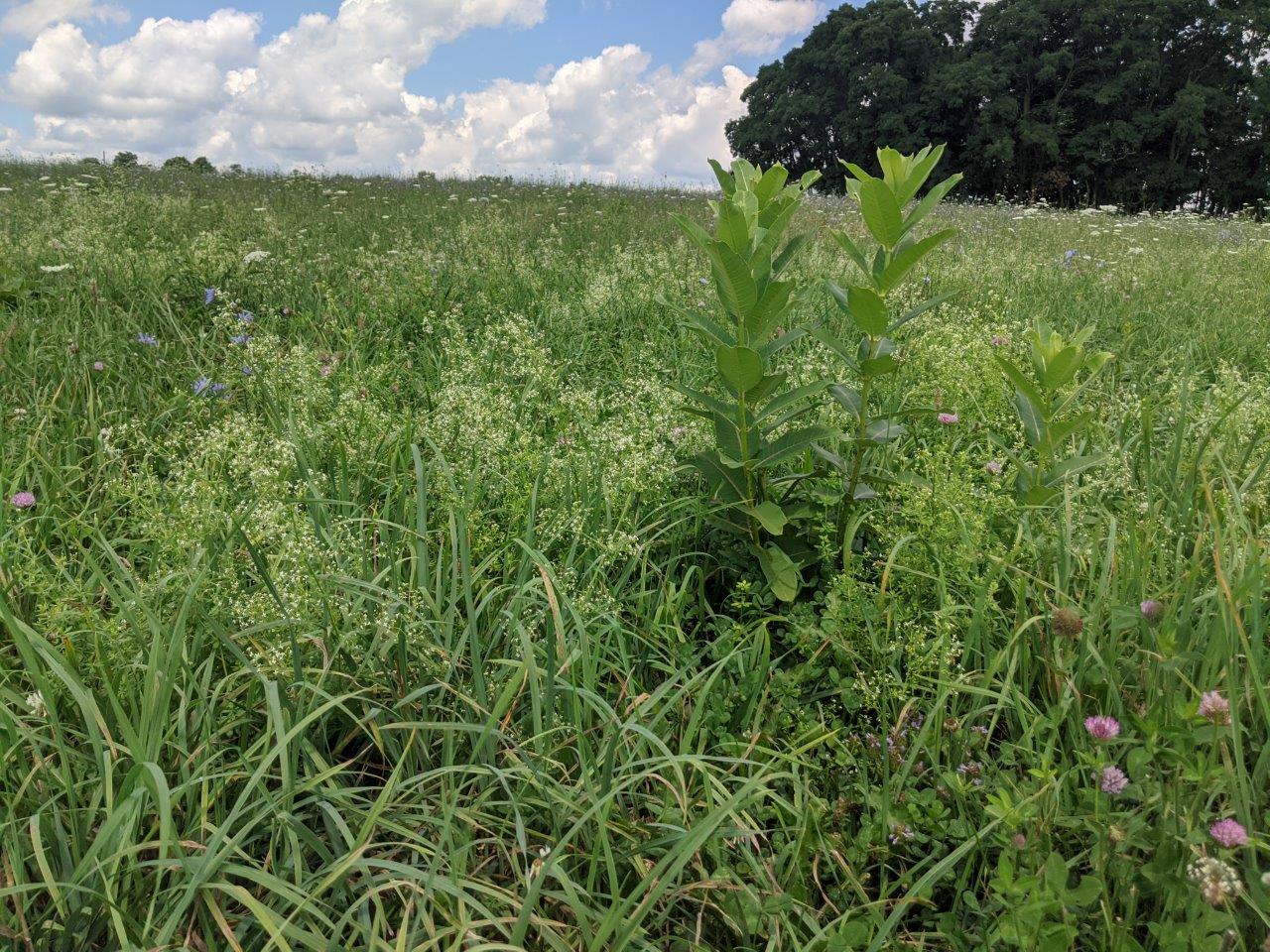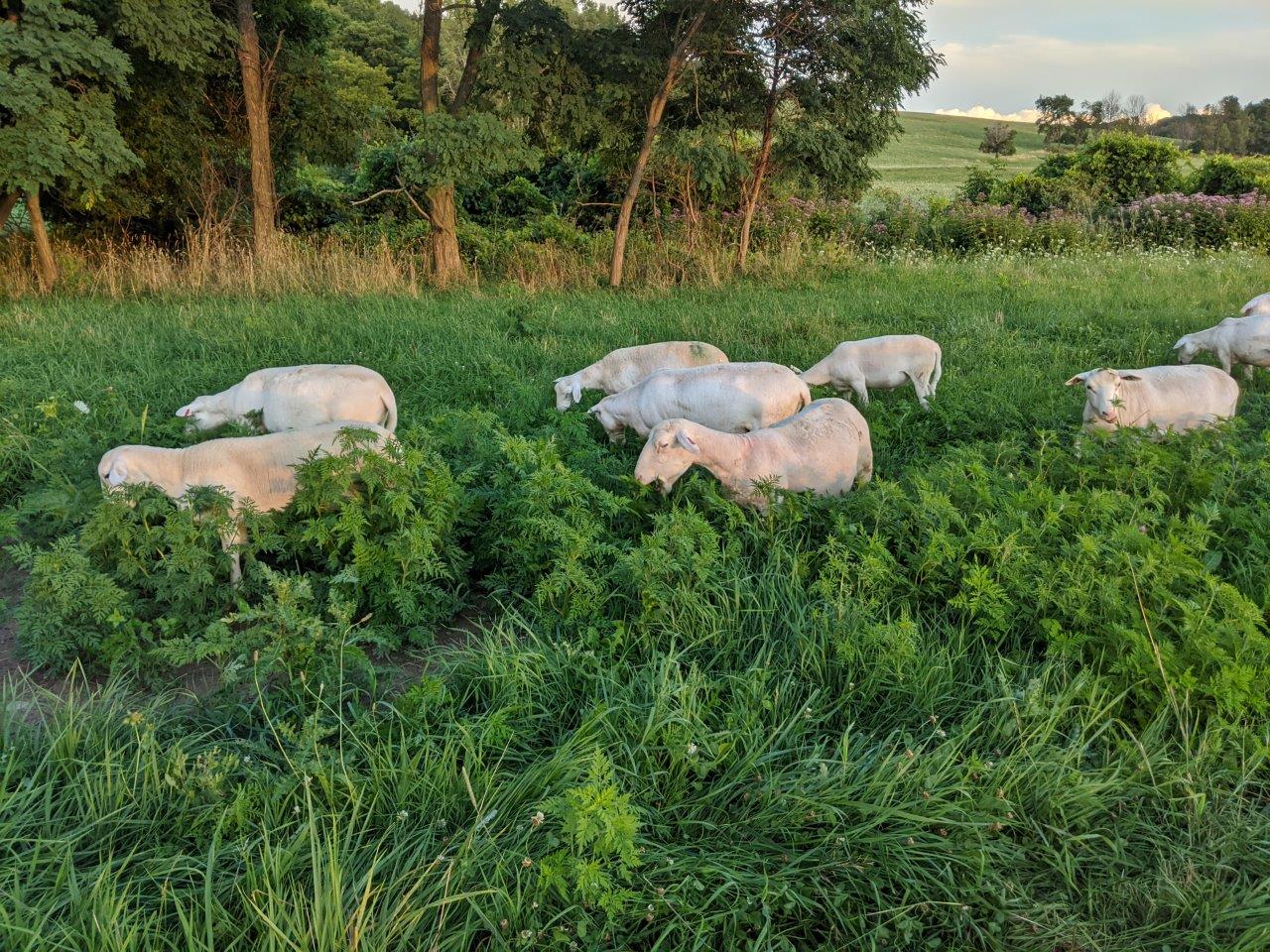When Is a Weed a Weed?
Determining which pasture weeds are nutritious additions and which are undesirable.

In the eastern US, milkweed is readily eaten by sheep without any poisonous effect.
Ulf Kintzel / White Clover Sheep Farm
Weeds are called weeds because we named them that way. The word “weed” suggests they are undesirable. However, not all weeds are created equal. This article addresses that.
Perennial pasture never contains just the planted and desirable forage species like the grass species and the legumes that were seeded. It will also contain weeds. Beginning farmers who seek my consulting services tend to think these weeds must be eliminated by either using herbicides or by plowing the sod under. In many cases, it is unlikely that either one is necessary.
What weeds could one find in perennial pasture? When I walk through mine, I encounter wild carrots, chicory, Canadian thistle, narrowleaf and broadleaf plantain, crabgrass, milk weed, quack grass, pig weed, rag weed, burdocks, white heath aster, musk thistle, spotted knapweed, hawkweed, bull thistle, prickly lettuce, sow thistle, dandelion, wild mustard, yellow rocket, lamb’s quarter, hedge and field bind weed, black medic, bird vetch, Pennsylvania smartweed, curly dock, butter cup, smooth bedstraw, and New England aster. Along the woods and hedgerows, as well as along the permanent fence, lines I have Tatarian honeysuckle, golden rod, multiflora rose, brambles, sumac, Virginia creeper, and wild grape. Some of these plants are widespread and can be found throughout my pasture. Dandelions and wild carrots (also called Queen Anne’s lace) are examples of that. Some of them have become rare and exist mostly along edges and hedgerows, such as golden rod and New England aster. Others are seasonal and only grow for a brief period in particular places. Rag weed and pig weed are examples of such weeds. However, despite the many weeds I listed, by far the dominant forage species are still the grass and legume species that I want in any of my pastures.
With few exceptions, I don’t mind many of the weeds. Some I even welcome because they are readily eaten, and they are very nutritious. Tests over the years have shown that many common weeds rival the nutritional value of forage species. Furthermore, variety in any pasture always increases intake. To understand that concept picture yourself having a prepared dinner versus being at a buffet. Chances are that one eats more at the buffet. What is not good for us is indeed good for sheep: maximum intake.

Rag weed that grew on a filled-in trench after tiling. It is eaten and will be gone in a year or two.
Ulf Kintzel / White Clover Sheep Farm
Furthermore, different plants provide different nutrients. For instance, deep-rooted plants like chicory can tap into deeper soils that contain more zinc. Other weeds produce ingredients with health benefits such as broadleaf and narrow leaf plantain.
Then there are indeed undesirable weeds. Some are poisonous plants but are not eaten and may be a nuisance. Plants like these are ground cherry, black and bittersweet nightshade, and butter cup. Others are not eaten and are simply a nuisance like stinging nettle and ground ivy. Then there are very undesirable weeds that are eaten (or their seeds) and spread because of it, such as Carolina horsenettle.
Thistles are undesirable as well. Bull thistle and the similar musk thistle are biennial plants. They establish themselves the first year and grow flowering stem in the second year. It is the second year when it is rather easy to curb the numbers of these thistles successfully. It has to be done at a certain time. About the timing I was told something like this: Kill it in June, and you will see it again soon. Kill it in July, and you can say goodbye.
When the plant is close to the end of flowering or is already developing seed, the plant may still produce seeds after it has been cut. The time of cutting is crucial, but the success rate is potentially very high. The common sight of a barn yard overgrown with bull thistles could easily look different if these thistles would be cut at the right time.
The only weed I truly dread is the Canadian thistle. Unlike the bi-annual bull and musk thistles, the Canadian thistle does not only spread by seeds but also spreads by rhizomes, just like quack grass. In some spots my sheep, and especially my goats, eat the Canadian thistle. In other areas, they do not touch them. I have not figured out why that is. In any event, they are a problem. I was told that repeated mowing would reduce and eliminate them. With that in mind, the pasture with the most Canadian thistles, which established themselves when a pumpkin field was reseeded, was hayed for a couple of years. It made no difference. Bush-hogging them may control the further spread but it does not kill them. So, if someone has some experience in getting rid of that weed, please let me hear it. Thus far I have only heard that it may be there because of the lack of certain nutrients. Even if that were to be true, it still doesn’t give me a tool to kill the existing thistles.
However, it is true that weeds can be indicator plants. More widespread growth of a certain weed might tell you that there is a certain prevailing condition in the area where it grows. For example, buttercup, poisonous to but not eaten by sheep, may indicate that you have a water surface drainage problem. An abundance of broadleaf plantain may indicate soil compaction. The presence of moss indicates acidic soils.
What is a good way to control the spread of weeds? A good rule of thumb is avoiding bare spots or thin growth in your pasture and instead having as dense of a pasture as possible. Bare spots are an ideal condition for weed seeds to get a footing. In addition, like any other plant, weeds have to compete for water, nutrients and light in the pasture and the more competitors they have, the harder it is for them to grow.
Another way of controlling the spread of weeds is bush hogging the pasture before they develop seeds or most of them start to develop seed heads. I bushhog my pasture starting in late June and up to mid-August, one grazing cell at a time after grazing. Primarily, I do it to eliminate seed heads of all my grasses and thus rejuvenate the pasture and encourage vegetative growth. I also do it to control the spread of weeds.
Draining or tiling wetter areas will reduce the growth of certain weeds. A desirable pH level as well as soils not lacking in nutrients help reduce the establishment of weeds. However, weeds eaten by sheep are not worth the effort trying to eliminate them. Remember, the nutritional value of them may be as high as your established forage species.

